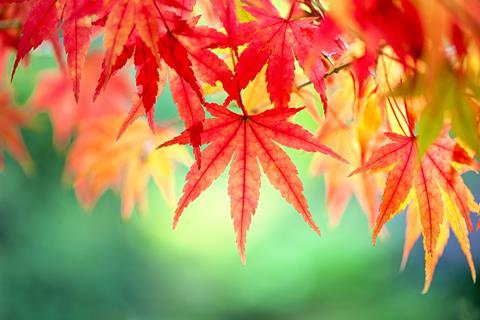Discover why leaves reveal their inner chemistry when chlorophyll breaks down – and how to brighten your lessons on colour changes with this context
Every autumn, nature swaps its coat of green for an ensemble of red, yellow, orange and brown. Fashion followers take inspiration from this seasonal shift. Preschoolers seek out the multicoloured leaves for crafts. While in Japan, hunting for autumn leaves is a national pastime – people stroll or hike along tree-lined pathways, lakeside trails and through valleys in search of autumnal scenes filled with the foliage of Japan’s famous red maples.
This seasonal shift is not so much a change, however, as a big reveal. Autumn is a great unmasking, in which many trees and other plants shed the green veils they have been hiding under and show us their true colours.
The chemistry of the colour changes
In spring and summer, plants focus on making the most of the longer, warmer days. They direct their efforts at producing chlorophyll, the pigment they use to capture energy from light for photosynthesis. This green pigment fills the light-harvesting chloroplasts inside plant cells and gives leaves their emerald tones.
But, as the days grow shorter and the nights get colder, plants stop making so much chlorophyll. This gives the other pigments inside leaves their time in the spotlight. The yellows and oranges come from pigments known as carotenoids. The same pigments give pumpkins and sunflower petals their autumnal hues. Carotenoids complement chlorophyll by absorbing light energy in a different part of the visible spectrum. Chlorophyll captures light in the violet-blue and red-orange wavelengths, whereas carotenoids absorb energy from blue-green light. Carotenoids are also more stable than chlorophyll so they hang around for longer inside leaf cells. This longer life means that as chlorophyll’s colour starts to fade, carotenoids’ colours start to show.
The big reveal
As the days grow shorter and the nights get colder, plants stop making so much chlorophyll. This gives the other pigments inside leaves their time in the spotlight. The yellows and oranges come from pigments known as carotenoids. The same pigments give pumpkins and sunflower petals their autumnal hues. Carotenoids complement chlorophyll by absorbing light energy in a different part of the visible spectrum. Chlorophyll captures light in the violet-blue and red-orange wavelengths, whereas carotenoids absorb energy from blue-green light. Carotenoids are also more stable than chlorophyll so they hang around for longer inside leaf cells. This longer life means that as chlorophyll’s colour starts to fade, carotenoids’ colours start to show.

Meanwhile, another pigment group – the anthocyanins – makes some leaves, including those of Japan’s red maple trees, appear red and purple in chlorophyll’s absence. Anthocyanins also give red fruits such as strawberries their colours. Scientists don’t fully understand all of the anthocyanins’ functions in plants. But the pigment is thought to have a protective role, defending leaves from light damage and from metals taken up from the soil and other stresses. The weather alters the richness of the pigments’ colours, too. Leaves produce more anthocyanin in colder, drier weather and accumulate more sugar in their cells when bright, sunny autumn days continue to drive photosynthesis through any remaining chlorophyll.
Why do leaves fall?
Preparing to fall
When all these pigments have in turn faded, leaves appear brown due to the unmasking of what remains – waste products from plant metabolism called tannins. Wine gets its bitter taste from these compounds. In the past, people also used tannins from trees like maple and willow to dye animal skins, turning them into leather. Tannins are large molecules that will bind with proteins, the cellulose in plant cell walls and other molecules to make insoluble substances that take a long time to break down. This is why they provide the last colour we see before the leaves fall from trees.
Trees lose their leaves to conserve energy during winter. As we head towards the colder months, at the base of each leaf stalk – where it attaches to the branch – cells form an abscission layer. This layer creates a barrier between the dying leaf and the rest of the plant, stopping trees from losing valuable nutrients. It is also the reason leaves can trap sugar, influencing anthocyanin production and red colours. Eventually, the links between trees and their leaves sever and the leaves fall to the ground.
Scientists are still debating why some trees keep their masks of green (evergreen) and hold on to their leaves all winter. But every autumn, we can admire those that show us their true colours.
Leaving already? Watch this TikTok before you go:
@royalsocietyofchemistry It's the time of the year where trees turn from green to red, but did you know there is #chemistry behind these changes? Ross shows us the various pigments that we see in #autumn and #fall #autumnleaves #learnontiktok ♬ Aesthetic - Tollan Kim
Hayley Bennett
Leaving already? Watch this TikTok (bit.ly/3LS61N2) before you go.














3 readers' comments